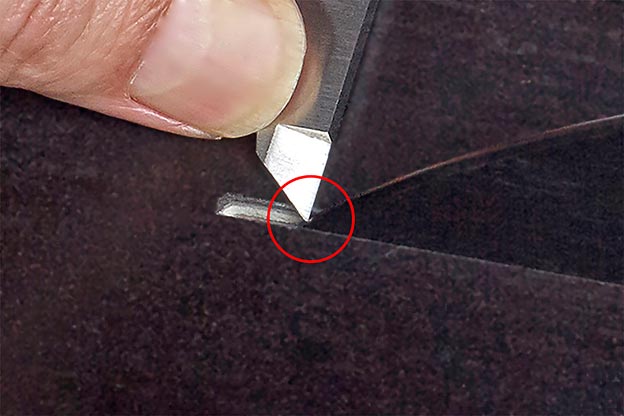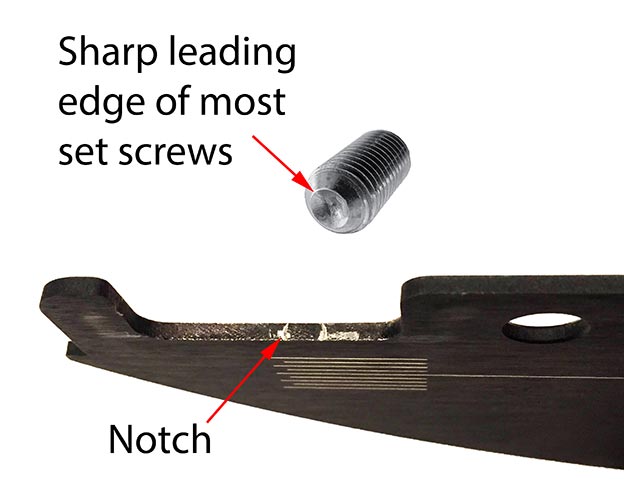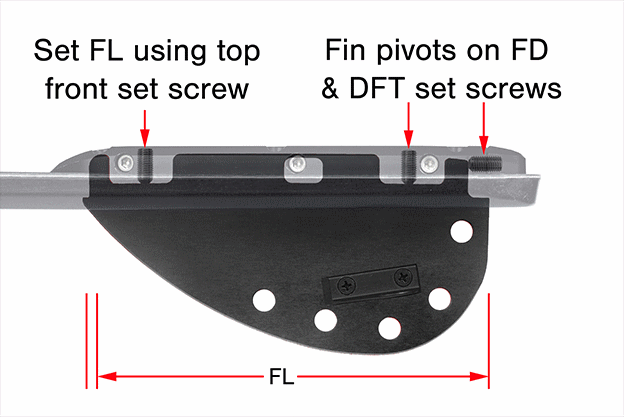Adjusting fin settings with any degree of accuracy is an acquired skill. While it’s not too hard to get fin depth (FD), fin length (FL), and distance from tail (DFT) all within .005” of the desired measurements, getting all three within .002” isn’t so easy, and getting them all to be exact after the fin block has been tightened up can be a test of patience. If you are finding it nearly impossible to be precise despite your best efforts, you may have some subtle fin damage working against you.
Water ski fins are made of aluminum or carbon, and their soft edges are easily nicked by the sharp hardened-steel edges of the calipers and fin block set screws they come into contact with. These nicks create measurement issues on two fronts: they restrict where the caliper can move along the fin’s leading edge; and they restrict how the fin moves relative to the set screws in the fin block.

Caliper tips and jaws are very sharp, and if we aren’t careful when taking fin measurements, we can cut small nicks into the delicate leading edge of the fin. During subsequent measurements, the caliper tip or jaw will continue to fall into the stepped notches we’ve created. This makes it impossible to get accurate measurements of small progressive fin movements.
These nicks and notches have to be carefully filed out of the fin’s leading edge before you’ll ever be able to get a proper measurement again. It doesn’t matter that this filing makes the fin a shade smaller because you will still set it to the perfect length when you put it back on the ski. Just make an effort to preserve the profile of the fin’s leading edge while filing. Then make sure any time the caliper touches the fin in the future, it is as gently as possible.
Another potential problem might be that the set screws in the fin block have cut notches into the fin. The leading edges of most set screws are very sharp hardened steel. If the fin doesn’t move easily in the fin block when the fin clamping bolts have been loosened off, the set screws will cut deep notches into the fin while pushing it into a new position. Set screws can also hammer notches into the fin if the fin is accidentally bumped against something hard enough to jam it into the set screws.

Once these set screw notches have been cut or knocked into the fin, trying to move the fin in small accurate increments will be impossible. Your measurements will jump all over the place every time you try to move the fin anywhere near one of these notches. Here again, the solution is to remove the fin and file any set screw notches completely out of it. Then play around with the way the fin block is fastened to the ski so that when the fin clamping bolts are loose, the fin moves fairly easily within the fin block. A fin block that allows the fin to move easily while loose and clamps firmly to the fin while tight will protect the fin from future set screw damage.
Finally, consider your level of patience with the adjustment process itself. Even if your fin has no issues with nicks or notches, it can still easily take a dozen or so rounds of adjustments to home-in on perfect settings. This is because every time we adjust one measurement, it will have a small effect on the other two measurements at the same time. The following animation illustrates how the fin moves around on the set screws during an exaggerated fin length (FL) change, and how that affects fin depth (FD) and the fin’s distance from tail (DFT):

Notice how much of the red fin gets exposed at the bottom and back of the fin. We wanted a FL reduction, but got a small decrease of FD and tiny increase in DFT in the process. And when we correct the unwanted changes to FD and DFT, FL will have gone back out of adjustment too. Don’t get frustrated and settle for “close enough”—this process is normal. The good news is that each round of corrective adjustments makes substantial progress towards your target numbers, so all three measurements should fall into place eventually—just stick with it.
That said, if you find after three or so rounds of adjustments that the numbers are not getting any closer to your target settings, or your numbers seem to be jumping around, there’s a very good chance your fin has nicks around its edges. Pull it out and carefully file out even the tiniest marks. Skillful filing won’t harm the fin one bit, and your repaired fin will allow you to make quick precise fin adjustments like a pro.
Note: If you find any of this a little confusing, rest assured that these concepts are all methodically explained and presented in an orderly fashion that anyone can follow in the book Fin Whispering—Demystifying the Black Art of Water Ski Tuning.
SkiJay
![]()

